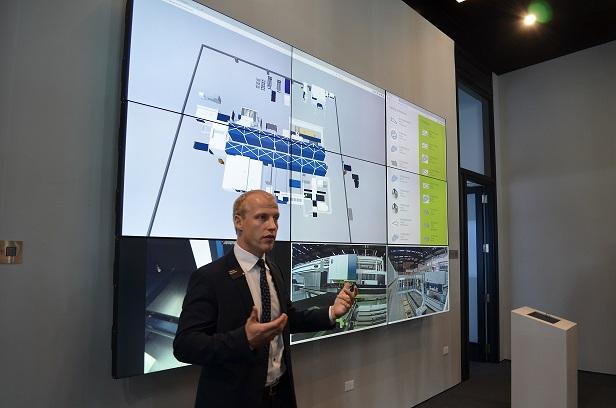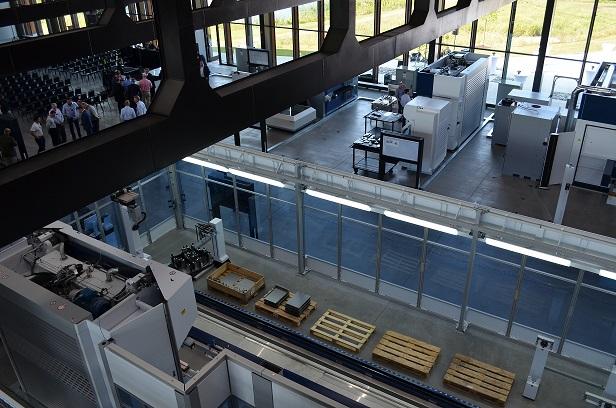Editor-in-Chief
- FMA
- The Fabricator
- FABTECH
- Canadian Metalworking
Categories
- Additive Manufacturing
- Aluminum Welding
- Arc Welding
- Assembly and Joining
- Automation and Robotics
- Bending and Forming
- Consumables
- Cutting and Weld Prep
- Electric Vehicles
- En Español
- Finishing
- Hydroforming
- Laser Cutting
- Laser Welding
- Machining
- Manufacturing Software
- Materials Handling
- Metals/Materials
- Oxyfuel Cutting
- Plasma Cutting
- Power Tools
- Punching and Other Holemaking
- Roll Forming
- Safety
- Sawing
- Shearing
- Shop Management
- Testing and Measuring
- Tube and Pipe Fabrication
- Tube and Pipe Production
- Waterjet Cutting
Industry Directory
Webcasts
Podcasts
FAB 40
Advertise
Subscribe
Account Login
Search
Not another equipment showroom
TRUMPF welcomes fabricators to its "smart" factory
- By Dan Davis
- September 15, 2017
- Article
- Laser Cutting

Figure 1. The new TRUMPF demonstration facility for Industry 4.0 manufacturing sits off Interstate 90 in the Chicagoland area, which makes it within close driving distance of about 40 percent of all metal fabricating operations in the U.S.
What does a picture of Sandy Koufax have to do with Industry 4.0?
Well, the picture in question is of Koufax holding four baseballs with a zero marked on each ball. It was taken after he threw a perfect game against the Chicago Cubs on Sept. 9, 1965. It also marked his fourth no-hitter.
This photo also will grace the cover of TRUMPF’s annual report, which will be available in the early fall. The focus of the report is Industry 4.0—the age of interconnectivity among equipment and people, no matter where they might be, that promises a new level of production efficiency not yet seen in manufacturing. What better way to express the potential to achieve “perfect” results in manufacturing and the “four zero” than to show one of baseball’s greatest heroes with his four perfect game balls?
Arguably, that Koufax picture may be a symbol that resonates more with baseball fans than with anyone else, but that’s OK. Metal fabricators that don’t appreciate baseball do know that they need to be constantly looking for cost savings—and perfection—in their operations. With the opening of its new, $15 million “smart factory,” as the company is calling it, in Hoffman Estates, Ill. (see Figure 1), TRUMPF is hoping to show fabricators just what the concept of “transparency” in manufacturing is all about and what it can do for their operations. In fact, TRUMPF hosted more than 200 guests at the facility’s grand opening on Sept. 12, where they got the chance to see how this modern manufacturing setup works.
“We come here to join together with our American customers in embarking on a new era in production marked by digital connectivity,” said Dr. Nicola Leibinger-Kammüller, president and chairwoman of the managing board of the TRUMPF Group.
Peter Hoecklin, president and CEO, TRUMPF Inc., said it made sense for the company’s fifth facility in the U.S. to be dedicated to exploring digital manufacturing. While the capital equipment investment cycle for metal fabricators is much shorter in Europe, where these companies have been early adopters of automation, when compared to their U.S. counterparts, Americans are much more comfortable with smart devices because they are much more integrated into their personal lives. Consumers in the U.S. expect digital interfaces for almost all interactions in their lives, and they are pretty comfortable with sharing data.
“I think in America, you are open to trying new things,” Hoecklin said during a press conference with the trade press.
So what does a smart factory look like? First, you won’t notice any paper around. That’s just one example of relying on this type of digital connectivity to reduce pre- and postproduction activities, which are the indirect costs that affect a fabricator’s profitability, according to Burke Doar, TRUMPF’s vice president, sales and marketing. The goal for such a smart factory would be to take a customer’s part file; feed that into a fabricator’s shop management software; finalize the part modeling; and then have the job order, work instructions, nesting, material requisition, scheduling, and other tasks automatically done with that original input of data. That’s the start of the process.
The second thing that a fabricator will notice at the new facility is that it’s hard not to notice what’s going on. Tobias Reuther, the director of the smart factory, said if a fabricator has not provided them with design files before a visit, the TRUMPF team needs only about 30 minutes to process the file and get it ready for production. When it’s ready to hit the facility’s production floor, the fabricator can keep tabs on the part from the second-floor control room (see Figure 2), from a conference room where monitors are embedded into the table, from the catwalk that hangs over the production area (see Figure 3), or from the floor itself.
On the production floor, visitors find a collection of the latest TRUMPF machine tools attached to a large automated material storage and retrieval system. There are no lift trucks moving sheet metal to dodge, however. Automated guided vehicles navigate the floor to feed the storage system.

Figure 2. Tobias Reuther, director of the TRUMPF smart factory facility, describes how fabricators can track their own parts once the job has been dispatched to the production floor. In the upper right-hand corner of the video monitor, visitors can see the parts that are in production and ones that are in the queue to hit the shop floor.
Around the material handling system, fabricators notice a TruMatic 6000 laser/punch combination machine, a TruLaser Center 7030 laser cutting machine with the latest in parts sorting technology, a TruLaser 5030 laser cutting machine, a TruBend Center 7030 panel bender, and a TruBend 5170 press brake with ToolMaster automated tool-changing technology. Reuther said that TRUMPF consultants and the fabricator customer can see what might be the best way to fabricate a particular part because all alternatives are available on this production floor.
If fabricator is involved in meetings or otherwise preoccupied and not paying attention to real-time updates on production parts at the smart factory, he won’t have a problem finding them in the new facility. Once parts are produced, they are scanned and married to a tag that travels with those parts. The system software knows where those parts are, and the visiting fabricator can easily track them from one of the numerous monitoring spots.
Hoecklin described the new facility as a laboratory of sorts where TRUMPF and fabricators can learn from each other. Technology advances and lean manufacturing practices have helped to squeeze plenty of waste out of actual metal fabricating processes, but much scrutiny still can be applied to the pre- and postproduction activities that haven’t changed much over the years. As modern technology helps to make these processes more transparent to the parties involved, they can be streamlined. Hoecklin hopes these types of discoveries can occur in Hoffman Estates, which also happens to be in the heart of metal fabricating in the U.S.
That’s TRUMPF’s pitch with its smart factory. Time will tell if digital manufacturing is a hit with U.S. metal fabricators.

Figure 3. Visitors to the TRUMPF facility can view production operations from a catwalk that runs through the building’s trusses. The truss work is unique because it’s not a large structural steel piece. It is actually made of sheet metal parts—240 of them to be exact—welded together to create three subsections and then joined together to form one truss.
About the Author

Dan Davis
2135 Point Blvd.
Elgin, IL 60123
815-227-8281
Dan Davis is editor-in-chief of The Fabricator, the industry's most widely circulated metal fabricating magazine, and its sister publications, The Tube & Pipe Journal and The Welder. He has been with the publications since April 2002.
Related Companies
subscribe now

The Fabricator is North America's leading magazine for the metal forming and fabricating industry. The magazine delivers the news, technical articles, and case histories that enable fabricators to do their jobs more efficiently. The Fabricator has served the industry since 1970.
start your free subscription- Stay connected from anywhere

Easily access valuable industry resources now with full access to the digital edition of The Fabricator.

Easily access valuable industry resources now with full access to the digital edition of The Welder.

Easily access valuable industry resources now with full access to the digital edition of The Tube and Pipe Journal.
- Podcasting
- Podcast:
- The Fabricator Podcast
- Published:
- 04/16/2024
- Running Time:
- 63:29
In this episode of The Fabricator Podcast, Caleb Chamberlain, co-founder and CEO of OSH Cut, discusses his company’s...
- Industry Events
16th Annual Safety Conference
- April 30 - May 1, 2024
- Elgin,
Pipe and Tube Conference
- May 21 - 22, 2024
- Omaha, NE
World-Class Roll Forming Workshop
- June 5 - 6, 2024
- Louisville, KY
Advanced Laser Application Workshop
- June 25 - 27, 2024
- Novi, MI































